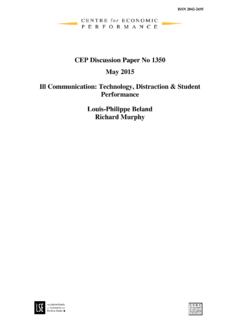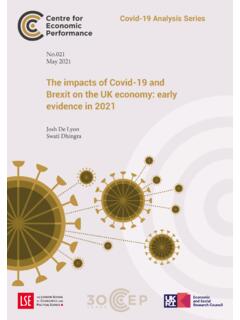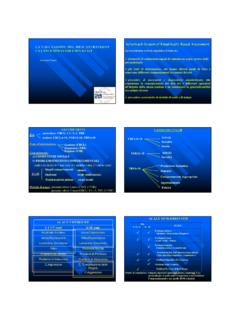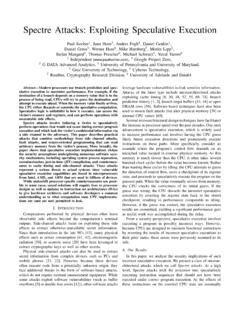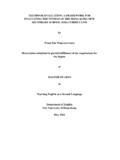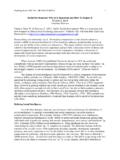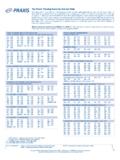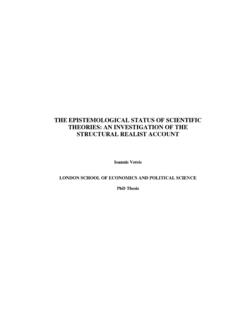Transcription of Economists for Brexit: A Critique
1 PAPERBREXIT06. Economists for brexit : #CEPBREXIT. A Critique Thomas Sampson, Swati Dhingra, Gianmarco Ottaviano and John Van Reenen Economists for brexit : A Critique CEP brexit ANALYSIS No. 6. Professor Patrick Minford, one of the Economists for brexit ', argues that leaving the European Union (EU) will raise the UK's welfare by 4% as a result of increased trade. His policy recommendation is that following a vote for brexit , the UK should strike no new trade deals but instead unilaterally abolish all its import tariffs. Under this policy ( Britain Alone'), he describes his model as predicting the elimination' of UK manufacturing and a big increase in wage inequality. These outcomes may be hard to sell to UK citizens as a desirable political option. Our analysis of the Britain Alone' policy predicts a loss of welfare compared with staying in the EU. This is only percentage points better than brexit without unilaterally abolishing tariffs which would result in a welfare loss.
2 Minford's results stem from assuming that small changes in trade costs have tremendously large effects on trade volumes: according to his model, the falls in tariffs become enormously magnified because each country purchases only from the lowest cost supplier. In reality, everyone does not simply buy from the cheapest supplier. Products are different when made by different countries and trade is affected by the distance between countries, their size, history and wealth (the gravity relationship'). Trade costs are not just government-created trade barriers. Product differentiation and gravity is incorporated into modern trade models these predict that after brexit the UK will continue to trade more with the EU than other countries as it remains our geographically closest neighbour. Consequently, we will be worse off because we will face higher trade costs with the EU. Minford's assumption that goods prices would fall by 10% comes from attributing all producer price differences between the EU and low-cost countries to EU trade barriers, ignoring differences in quality.
3 Single Market rules (for example, over product safety) facilitate trade between EU. members as it creates a level playing field. Minford's assumption that the Single Market merely diverts trade from non-EU countries is contradicted by the empirical evidence. Minford also overlooks the loss in services trade that would result from leaving the Single Market, such as passporting' privileges in financial services. Minford's approach of ignoring empirical analysis of trade data seems predicated on the view that because statistical analysis is imperfect, it should all be completely ignored. But such statistical biases may reinforce rather than weaken the case for remaining in the EU. Theories need grounding in facts, not ideology. 1. Disclaimer: The Centre for Economic Performance (CEP) is a politically independent Research Centre at the London School of Economics. The CEP has no institutional views, only those of its individual researchers.
4 Professor John Van Reenen who joined the CEP as Director in 2003, did not (and does not) support joining the Euro. CEP's brexit work is funded by the UK Economic and Social Research Council. As a whole the CEP, receives less than 5% of its funding from the European Union. The EU funding is from the European Research Council for academic projects and not for general funding or consultancy. Introduction Much publicity recently surrounded Economists for brexit ' (2016a, 2016b). Since the economic case for leaving the European Union (EU) has been largely missing in action, it is refreshing to obtain some clarity over the Leave campaign's vision of the UK's post- brexit economic arrangements. Professor Patrick Minford of Cardiff University is the only one of the group who has provided some economic modelling. He predicts that there would be a welfare gain of 4% of GDP by 2020 if the UK were to leave the EU.
5 This prediction is surprising because just about every other piece of economic analysis finds negative economic effects from the UK leaving the EU. (for example, Dhingra et al, 2016a; HM Treasury, 2016; NIESR, 2016; OECD, 2016; PWC, 2016). Such studies simply remind people that the EU has been good for trade and trade is good for welfare. It follows that leaving the EU will reduce trade and so have an economic cost. The main question is not so much the direction of the effect, but rather the magnitude of the hit to living standards. There may be offsetting or reinforcing factors from other things such as regulation, foreign investment, immigration, lower fiscal transfers to Brussels, uncertainty and so on but distancing ourselves from our closest trading partner could not be beneficial for trade. Yet Economists for brexit make just such a claim, so we were curious to understand where Minford's positive effects come from.
6 We summarise the main points of our analysis here and leave more technical details to the Annex. Britain Alone' unilateral free trade One feature of Minford's approach is that after leaving the EU, the UK is assumed to trade simply under World Trade Organization (WTO) rules, without seeking a new trade agreement with the EU or other trading partners like the United States. The UK would simply pay the external tariffs. This is usually the worst case scenario that other Economists have modelled. HM Treasury (2016), for example, finds a GDP drop of under this scenario. A second feature of the Minford argument is the assumption that the UK will unilaterally drop all its trade protection against imports from everywhere else in the world after brexit . One reason why most Economists have not focused on this scenario is that it seems politically unlikely. As far as we know, no developed country has ever unilaterally removed all manufacturing tariffs against all other countries Minford's Britain Alone' scenario.
7 In fact, one can easily imagine the UK establishing greater trade protection after brexit . For example, the recent furore over Port Talbot's steelworks suggests that domestic political pressures may have pushed the government to increase tariffs on Chinese steel. Indeed, Minford describes in his model that an implication of the Britain Alone' policy (Minford et al, 2016, p. 74 Table ) is that it will effectively eliminate manufacturing' in the UK. Another implication of his preferred policy is a dramatic increase in wage inequality: skilled workers'. nominal wages increase by around 11%, but unskilled workers' wages fall by 14%.1 These changes are unlikely to be an easy sell politically, to say the least. 1. These inequality changes will not be offset by reductions in EU immigration as the impact of immigration on inequality is close to zero (Wadsworth et al, 2016). 2. Nonetheless, standard economics does suggest that there will be some benefits from unilateral trade disarmament'.
8 Indeed, in the work we published in March (Dhingra et al, 2016a, Table 2) we look at what would happen if the UK eliminated all tariffs after We find that if the UK trades under WTO rules following brexit , but maintains import tariffs, then UK income per capita falls by Under Minford's Britain Alone' scenario of unilateral liberalisation after brexit only, UK real incomes still fall by In other words, there is a gain of only percentage points from eliminating tariffs compared to just trading under WTO rules this is completely insufficient to offset the other trade costs of brexit . So the real question is not whether moving to unilateral free trade can have some benefits in economic models, but rather: Why the benefits are so big in Minford's model (over ten times what we find)? Why are there no welfare costs in Minford's model from lower UK exports to the EU. after brexit ? The answers to these questions require an understanding of how thinking about the economics of trade has developed in the last five decades, and how these features are overlooked in the Minford approach.
9 The basic idea There are basically two steps in Minford's analysis. First, he assumes that because of EU tariff and non-tariff barriers, prices paid by UK consumers for manufacturing and agricultural goods would fall by 10% under his Britain Alone' policy recommendation. Second, he feeds this 10% tariff equivalent fall in trade costs into his Liverpool model' to come up with a GDP. increase of 4% (roughly speaking, the increase in GDP is much less than 10% because people consume a lot of services, which are not directly affected by brexit under Minford's assumptions). The 10% fall in trade costs How on earth can trade costs fall by 10% when the UK's average tariff is currently around 3%? The answer is that the 10% number does not come from looking at the actual level of tariffs. It comes from looking at the differences in price levels between the UK and some other countries and arguing that these higher prices are due to protectionism caused mainly by EU regulations (non-tariff barriers).
10 We go through this in detail in the Annex, but there are several very basic problems. First, the estimates he makes are from data in 2002 - 14 years out of date. Second, it seems extraordinarily unlikely that all the cross-country price differences are really from trade protection rather than a multitude of other factors, such as quality differences, variation in producer mark-ups or measurement error in estimates of distribution margins. For example, say Europeans put a higher premium on high-quality clothing compared with Americans. It will look like Europeans are paying more for their clothes, but in reality, the higher average prices simply reflect a different mix of purchases we are comparing apples 2. Mr. Minford is under the misapprehension that we did not look at his Britain Alone' recommendation, but this is because he only refers to the work from two years ago (Ottaviano et al, 2014) and not the recent work (for example, Dhingra et al, 2016a).
